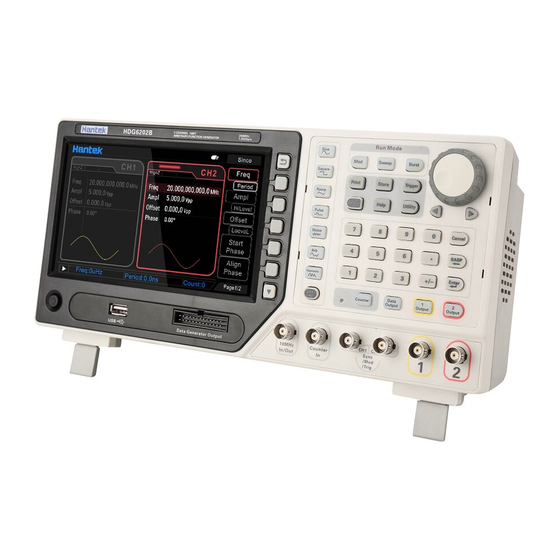
Table of Contents
Advertisement
Advertisement
Table of Contents

Summarization of Contents
Safety Requirements
General Safety Summary
Read safety precautions to avoid injury and prevent damage. Use product only as specified.
Safety Terms and Symbols
Product Scrapping
Information on device recycling and proper disposal to avoid environmental harm.
Chapter 1 Quick Start
General Inspection
Check shipping container, accessories, and instrument for damage or defects upon receipt.
Front Panel
Description and introduction to the front panel components and their functions.
Rear Panel
Overview of the rear panel connectors and ports.
Prepare Instrument for Use
Steps to adjust supporting legs and connect the power cord before operating.
The user interface
Explanation of the instrument's display regions: status panel, menu panel, and window area.
Parameter Setting Method
Instructions on using the numeric keyboard, direction keys, and knob for parameter input.
Help
How to access context-sensitive help information using the Help key.
Chapter 2 Basic Waveform Output
Select the channel
Guide to selecting a single or dual channel for waveform output.
Setting the parameter
Details on configuring waveform parameters like frequency, amplitude, and offset.
Basic Waveform Output Example
Step-by-step example of configuring the generator to output a pulse waveform.
Chapter 3 Arbitrary Waveform Output
Enable Arbitrary Waveform
Steps to enable the arbitrary waveform function and set basic parameters.
Select Arbitrary Waveform
Guide to selecting built-in or user-defined arbitrary waveforms from internal/external memory.
Chapter 4 Harmonic Output
Overview
Explanation of harmonic output and Fourier transform principles.
Set the Fundamental Waveform Parameters
Configuring frequency, period, amplitude, and phase for the fundamental waveform.
Set the Harmonic Order
Specifying the highest order of harmonic to be output, up to the 16th order.
Select the Harmonic Type
Choosing between even, odd, or all harmonic types for output.
Set the Harmonic Amplitude
Setting the amplitude for each specified harmonic order.
Set the Harmonic Phase
Configuring the phase for each specified harmonic order.
Chapter 5 Modulated Waveform
AM Modulation
Configuration and parameters for Amplitude Modulation (AM).
DSB-AM Modulation
Configuration and parameters for Double Sideband Amplitude Modulation (DSB-AM).
FM Modulation
Configuration and parameters for Frequency Modulation (FM).
PM Modulation
Configuration and parameters for Phase Modulation (PM).
2ASK
Configuration and parameters for Amplitude Shift Keying (2ASK) modulation.
2FSK
Configuration and parameters for Frequency Shift Keying (2FSK) modulation.
2PSK
Configuration and parameters for Phase Shift Keying (2PSK) modulation.
BPSK
Configuration and parameters for Binary Phase Shift Keying (BPSK) modulation.
QPSK Modulation
Configuration and parameters for Quadrature Phase Shift Keying (QPSK) modulation.
3FSK Modulation
Configuration and parameters for 3-Frequency Shift Keying (3FSK) modulation.
4FSK Modulation
Configuration and parameters for 4-Frequency Shift Keying (4FSK) modulation.
OSK Modulation
Configuration and parameters for Oscillation Shift Keying (OSK) modulation.
PWM Modulation
Configuration and parameters for Pulse Width Modulation (PWM).
Chapter 6 Sweep
Select Frequency Sweep
Enabling and configuring the frequency sweep function.
Start Frequency and Stop Frequency
Setting the upper and lower frequency limits for sweep operation.
Center Frequency and Frequency Span
Defining sweep boundaries using center frequency and span.
Linear sweep
Configuring the instrument for linear frequency sweep type.
Sweep Time
Setting the duration for the sweep from start to stop frequency.
Return Time
Specifying the time to return from stop frequency to start frequency.
Hold Time
Setting the duration to remain at the stop frequency during a sweep.
Mark Frequency
Defining a frequency point that triggers a sync signal change.
Sweep Trigger Source
Selecting the source (Internal, External, Manual) for sweep triggering.
Trigger Output Edge
Configuring the edge polarity for trigger output signals.
Chapter 7 Burst
Select Burst Mode
Enabling and configuring the burst output mode.
Burst Type
Selecting between N Cycle, Infinite Cycle, and Gated burst types.
Burst Period
Setting the period for N Cycle bursts in internal trigger mode.
Burst Phase
Defining the phase of the start point of the burst waveform.
Burst Trigger Source
Selecting the source (Internal, External, Manual) for burst triggering.
Gate Polarity
Setting the polarity for gated burst mode (Positive or Negative).
Trigger Output Edge
Configuring the edge for trigger output signals in burst mode.
Chapter 8 Counter
Enable the Counter
Activating the instrument's counter function.
Set the Counter
Configuring gate time, sensitivity, and trigger level for the counter.
Chapter 9 Digital Generator
Terminal Description
Description of the digital generator terminals and their functions.
Function Introduction
Overview of digital generator functions: Sync Signal and Programmable Signal.
Chapter 10 Utility
Sync
Configuration of sync signal output for basic, modulated, and burst waveforms.
Impedance
Setting the output impedance (50Ω or HighZ) for channels.
Network for HDG6000C
Configuring LAN, WLAN, and Hotspot interfaces for remote communication.
System Setting
Configuring system language, power-on settings, sound, and screen intensity.
Print
Saving screen contents to a USB storage device in BMP format.
Update
Procedure for updating the instrument's firmware.
Store and Recall
Saving and loading instrument states and arbitrary waveform files.
Chapter 11 Remote Control
Install Keysight IO libraries suite
Instructions for installing the necessary software suite for remote control.
Remote Control via USB
Connecting and controlling the instrument via USB.
Remote Control via LAN (HDG6000C)
Connecting and controlling the HDG6000C via LAN.
Remote Control via WLAN (HDG6000C)
Connecting and controlling the HDG6000C via WLAN.
Remote Control via Hotspot (HDG6000C)
Connecting and controlling the HDG6000C via its Hotspot feature.




Need help?
Do you have a question about the HDG6202B and is the answer not in the manual?
Questions and answers